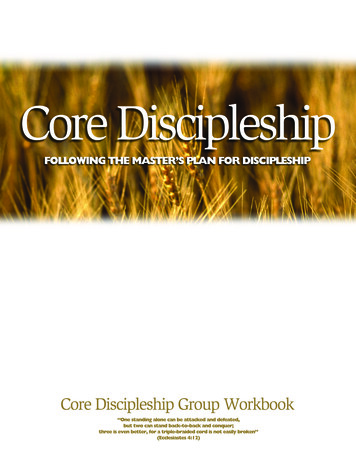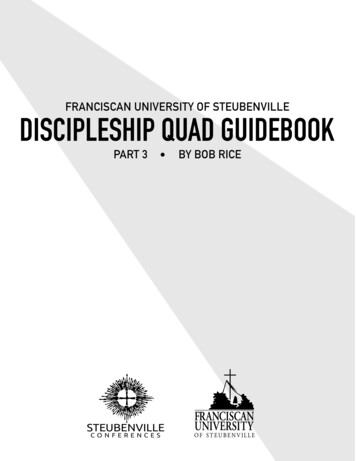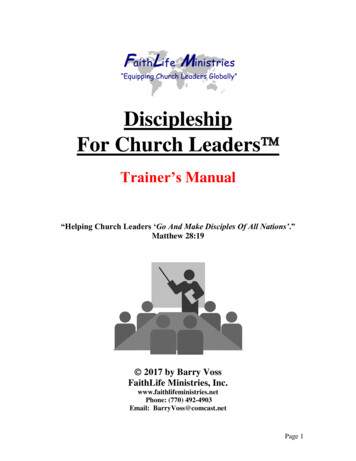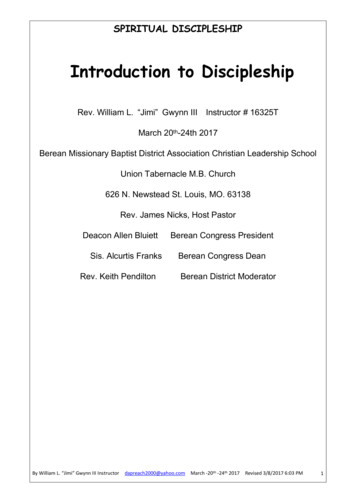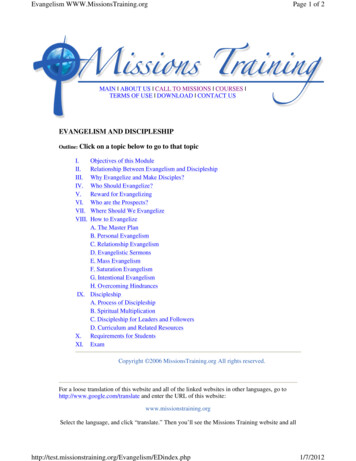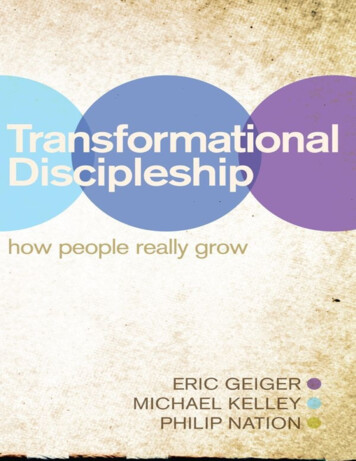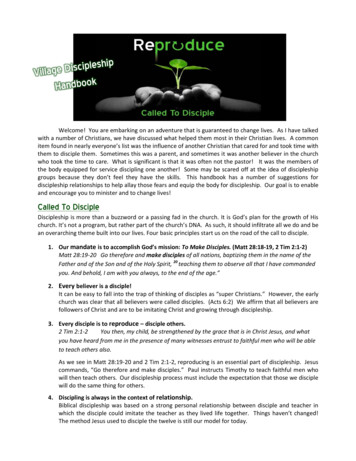
Transcription
Welcome! You are embarking on an adventure that is guaranteed to change lives. As I have talkedwith a number of Christians, we have discussed what helped them most in their Christian lives. A commonitem found in nearly everyone’s list was the influence of another Christian that cared for and took time withthem to disciple them. Sometimes this was a parent, and sometimes it was another believer in the churchwho took the time to care. What is significant is that it was often not the pastor! It was the members ofthe body equipped for service discipling one another! Some may be scared off at the idea of discipleshipgroups because they don’t feel they have the skills. This handbook has a number of suggestions fordiscipleship relationships to help allay those fears and equip the body for discipleship. Our goal is to enableand encourage you to minister and to change lives!Called To DiscipleDiscipleship is more than a buzzword or a passing fad in the church. It is God’s plan for the growth of Hischurch. It’s not a program, but rather part of the church’s DNA. As such, it should infiltrate all we do and bean overarching theme built into our lives. Four basic principles start us on the road of the call to disciple.1. Our mandate is to accomplish God’s mission: To Make Disciples. (Matt 28:18-19, 2 Tim 2:1-2)Matt 28:19-20 Go therefore and make disciples of all nations, baptizing them in the name of theFather and of the Son and of the Holy Spirit, 20 teaching them to observe all that I have commandedyou. And behold, I am with you always, to the end of the age.”2. Every believer is a disciple!It can be easy to fall into the trap of thinking of disciples as “super Christians.” However, the earlychurch was clear that all believers were called disciples. (Acts 6:2) We affirm that all believers arefollowers of Christ and are to be imitating Christ and growing through discipleship.3. Every disciple is to reproduce – disciple others.2 Tim 2:1-2You then, my child, be strengthened by the grace that is in Christ Jesus, and whatyou have heard from me in the presence of many witnesses entrust to faithful men who will be ableto teach others also.As we see in Matt 28:19-20 and 2 Tim 2:1-2, reproducing is an essential part of discipleship. Jesuscommands, “Go therefore and make disciples.” Paul instructs Timothy to teach faithful men whowill then teach others. Our discipleship process must include the expectation that those we disciplewill do the same thing for others.4. Discipling is always in the context of relationship.Biblical discipleship was based on a strong personal relationship between disciple and teacher inwhich the disciple could imitate the teacher as they lived life together. Things haven’t changed!The method Jesus used to disciple the twelve is still our model for today.
What is a disciple, discipleship, and discipling?We want to start by defining what we mean by some key words used in our call to discipleship. The biblicalwords used for discipleship mean to follow, adhere to, and imitate/copy a teacher and his life. Thus, adiscipler shows what it means to live in Christ and the disciples watch and imitate them. It is much likeplaying follow the leader when we were children! If you missed the Reproduce sermon series, weencourage you to go online and listen to the series where we explore these in detail. Disciple: one who has come to Jesus for eternal life, has claimed Him as Savior and God, and hasembarked upon the life and relationship of following Him.: A believer! Discipleship: The lifelong process of growing as a disciple. Discipling (Disciple making): An intentional relationship to walk life with another so that you canencourage, equip, and challenge each other with loving accountability to follow Christ and discipleothers. (Matt 28:18-19, 1 Cor 4:16-17)Seven Results When the Church Body Disciples1. Expanded Reproduction/Multiplication of disciples beyond what a few could do.2. Raises up leaders and teachers as people minister.3. Allows more to experience the enabling power of Christ as they disciple and rely on Him.4. Pastoral care of the body by the body. More people get cared for!5. Helps us not lose the wisdom from those who have gone before reaffirming their significance in thechurch.6. Deepens commitment to Christ in all involved – spiritual maturity.7. God is glorified!
Five Marks of a True Disciple:To disciple well, we must have a picture of what a disciple looks like so that we know where to head. If weaim at nothing, we are sure to hit it. The marks of a disciple both give a standard to live up to as well asareas to develop in those we meet with. While there are many things descriptions we could use to describea disciple of Christ, John 15:5-17 gives a wonderful picture of a disciple summarized in five different marks.Each is followed with some practical ways to apply it.1. Spiritual Growth: Abides in Christ and His Word (John 8:31-32; 15:5-7) Is a student of God’s Word – love it! Live it! Has an active devotional life. Lives in obedience to Word / Free from bondage of sin. Trusts God. Practices spiritual disciplines. (Memorizing, meditating, prayer, tithing, etc.)2. Community: Loves others as Christ loves (John 13:34-35; 15:12-14, 17) Regularly attends church. Acts in a loving way towards others. Meets needs of others. Intentionally welcomes others into the family.3. Ministry / Outreach: Bears fruit (John 15:8-9, 16) Exhibits fruit of the spirit (Gal 5:22-23). Makes disciples and has a heart for the lost. Serves in the church.4. Glory: Glorifies the Master above all else (John 15:8) Worships. Commits to abandon self.5. Joy: Lives a life characterized by God’s joy (John 15:11) Has peace that God is handling all circumstances.
Essential Ingredients to effective discipleship relationships:What should be part of a discipling relationship? Some may say we should just get together and talk sports.Others may want to just pray for each other and nothing else. The ingredients of a discipleship relationshiphowever, should directly encourage the marks of a disciple. Just like you would not leave out severalingredients when baking a cake, we should not leave out ingredients in the discipling relationship. For eachof these, consider how you might incorporate them into your discipleship time. Our desire is not to scripteach meeting or exactly what you should do, but give tools and ingredients that you can then put together.1. The Word: The study, memorization and application of God’s Word.Be intentional to spend time in your agreed upon Bible study. Times ofsharing can easily fill the whole time, but an essential ingredient is the studyof the Word. Work to keep this time an opportunity for all to participaterather than any one dominating. This aspect may take about 30 minutes ofyour time. If you are reading a book together, it is helpful to go through achapter a week. Each person should read the chapter before you meet.During your time then, you can go through the study questions or give time for each person toshare what God taught them in this chapter. Each resource should use the Word of God as thefoundation for its teaching.Scripture memorization is a spiritual discipline that we recommend be part of your discipleshipgroups. This is an effective way to remember God’s Word, meditate on it, and allow it to confrontsin in our lives. Try selecting one verse each week as a group and then have each person review theverse the next week. Some of the resources have a suggested memory verse, or you can select onefrom the study. Try this and see how God uses it!2. Accountability: Real mutual accountability leading to obedience.Each time you meet, be willing to ask real, tough questions regarding the spiritual life of the othersin the group. Discipleship challenges us to grow. Iron sharpens iron, not just sits next to iron.Lovingly hold each other to your spiritual commitments and a life of holiness. When thinking ofspiritual discipline goals, help your accountability partners be realistic. A goal of reading the Biblefor 2 hours each day will probably not be possible, but a shorter time period will be. Some ideasfor accountability items are . . . Bible Reading/Quiet time. Daily prayer times or prayer for each other. Being involved in ministry at church. Praying for individuals looking for opportunities to share the gospel with them. Church attendance. Any weakness that the person has asked for prayer or help with. Verse memorization.3. Prayer: Serious prayer for each other.Include a time of prayer requests and prayer for each other in every meeting. Find a way for all toremember the requests and pray for each other throughout the week. God has instructed us tocome to Him in prayer. Let’s obey Him!4. Relationship: Personal transparent relationships that show care.Part of your time should be devoted to finding out how people are doing and caring for them.Usually I would start the time with asking how everyone is doing. You may hear about work, home,
or just about anything. These discussions are important to building relationships. Remember tolive life together. Find out things like birthdays, anniversaries, kids events, etc.Effective groups do things together as well! Plan some sort of fun activity together at least onceevery couple months. This might be a meal, game night, sports event, or something else everyoneenjoys. If your schedules are swamped, use your discipleship time once every couple of months toaccomplish this. Building relationships in this way will add much to your discipleship.5. Ministry / Service: Actions that put others first by encouraging service or serving together.Make sure to talk about where each one is serving or where they would like to serve. If they arenot in ministry somewhere, encourage them to take the initiative and ask for some ideas ofministry involvement. Just like described above, an important part of discipleship is to take sometime to minister together. You are discipling if you occasionally take some time when you wouldmeet together to go minister to someone. Make this a regular part of your group!6. Reproduction: Discipleship always has a goal of reproducing more disciples.One of the goals for discipleship relationships is to teach others to do the same thing with others!As we do this, the body of Christ is able to equip and train far more than just the elders can. Fromthe initial commitment to the various discussions you have, often bring up the idea of disciplingothers. Then about half way through your discipleship time frame (maybe 4 to 6 months in), askeach person to start to pray for who they will disciple. One month before the end of your group,have each member invite the people God has put on their hearts to their own group. This will allowyou to disciple them through the initial process of starting discipling relationships.7. Commitment: Count the cost for the glory of God and His mission.The expectations of a discipling relationship should be discussed from the beginning of the groupusing the discipleship covenant below. Then hold each other accountable to those expectations.Without commitment, the groups quickly lose focus and eventually disband.8. Enjoyment! Effective relationships exhibit God’s joy.Keep things flexible enough to truly enjoy each other’s company. If you find that meeting isbecoming a chore and the enjoyment is waning, examine whether you are doing enough to buildrelationship. As we mention above, go do something random together! Finally, laugh . . . a lot!
Choosing Discipling RelationshipsAnd he said to them, “Follow me, and I will make you fishers of men.” (Matt 4:19)First and foremost, we want the forming of disciplingrelationships to be directed by the Holy Spirit. Wehave chosen not to have signups and create thegroups as a church program. Rather, we believe thatas each believer prays and seeks God’s guidance, theHoly Spirit will direct you to those He would have yoube in discipling relationships with. If you are seekingto disciple others, we encourage you to begin yourinvestment in them by initiating the relationship. Thisthree step process is outlined below. If you want tobe discipled and are not sure where to begin, wewould love to help facilitate that relationship. Contactany of the elders, Pastor Andrew, or Pastor Ron andwe will help you find a discipleship relationship thatwill help you grow!1. Pray – As Jesus retreated alone to pray before making the decision to call His disciples, so weshould commit serious time in prayer asking for God’s direction regarding this vital relationship.2. Decide – Choose one or two people of the same gender to invest discipling time into. While adiscipleship relationship can be just two people, we highly recommend groups of three. This allowsa multiplication of insights, accountability, investment and involvement. It also helps make themeetings more comfortable as any one person does not have to carry the conversation. You mightchoose one person you know and one person you do not know well. We encourage you to choosepeople that are able to see your life. It is great to start with people already in your ministry or thatyou already have natural relationships with. Then include them in your ministry times or normaltimes of life. Discipling is living life together! As you choose, consider the principle of mutuality aswell. While discipling relationships are often the older teaching the younger, they can also bebetween three peers that are seeking to disciple each other. Allow God to put people on yourheart! Finally, follow Paul’s instruction in 2 Tim. 2:2 where he says, “entrust to faithful men whowill be able to teach others also.” Choose men and women who will seek God and have an openheart to His leading.3. Ask – After prayerfully choosing discipleship partners, go to them and initiate a conversation askingif they are interested in forming a discipleship group. You make a powerful statement by going tosomeone and communicating that you would like to invest in their spiritual lives. This isn’t alwayscomfortable, but God’s mission is far more important than our comfort. In this conversation, besure to explain that a discipleship group is a mutual commitment by all involved. Don’t sucker themin with the promise of ease and just getting together, and then pounce on them with a heavyworkload of homework and accountability. Be up front and watch people rise to the occasion!
Getting Started:Once you have your discipleship group set, it is time to get started! There are a few things you shoulddecide as a group. Time Frame – How long are you committing to meet together for? While discipling relationshipsare relationships that never really end, this decision is referring to the formal length of time you arecommitting to. This may depend on the material you choose. We recommend periods of 9 monthsto a year as you need enough time to get to know each other and build into each other’s lives. Atthe end of the time, the decision can be re-visited. Remember, one of the goals is to reproduce! Frequency – How often are you able to meet and for how long? Groups should meet either weeklyor every two weeks. If meetings are any further apart, it becomes very difficult to haveaccountability and effectiveness in each other’s lives. The biblical model of discipleship includesseeing each other’s lives and modeling. It is hard to do that without regular contact. Choose Material – What material do we want to go through to be including the Word in our time?Rather than have one curriculum that every group goes through, we would rather each groupchoose material that will challenge them to apply scripture to their phase of life and walk with God.There is a list of resources at the end of this handbook that gives a number of recommendedoptions. Feel free to ask any of the elders and pastors for input as well. As you use a resource, wewould love feedback as to how it is working and ideas for other leaders when they use it. Please letPastor Andrew (andrew@villagebible.com) or Pastor Ron (ron@villagebible.com) know. Covenant – What are the expectations of the group? Below is a sample covenant outlining what isexpected from those in discipleship groups. This should not be used to bludgeon people intosubmission, but is a great opportunity to discuss what expectations are essential for discipleship towork well. This might be a good document to cover your first time meeting together.What should a meeting look like?A discipleship meeting can be flexible and include the elements of discipleship in a variety of formats. Youcould meet in your home, office, a restaurant, or anywhere else that will allow you private, uninterruptedconversation. Below is a sample meeting and is a model (not a script!) that you can adjust for your needs. (20 to 25 minutes) Start with a time of sharing. Go around and ask each person how their lastweek has been. This is a great time to address any specific things that this person has asked forprayer on. For instance, you may ask, “So how did the situation at work go?” Be direct! You mayneed to help them share by asking questions like, “What has gone well this week?” or “Where haveyou struggled this week?” Ask how they are doing in their spiritual walk. Asking good questionsleads to great sharing. Another great question is “What has God taught you this week?” (5 to 10 minutes) Memory review. Have each one quote last week’s verse (30 to 40 minutes) Spend time discussing the agreed upon study. Be sure to focus on the scripturein the study. Decide on next week’s memory verse. (10 to 15 minutes) A time of application and accountability. Go around and ask each person whatthey want to apply from the lesson. (15 minutes) Prayer – Ask for something that you can pray for from each person. Include requestsregarding each one’s spiritual walk here as well. Ask about and pray for their own discipleshipopportunities here as well. (5 to 10 minutes) Review the following week’s assignment and verify your next meeting. This isalso a good time to plan any upcoming fellowship times or service opportunities.
Responsibilities of the Discipler Commitment to care – Discipleship is more than a program or a stamp in your bible. (1 Thes 1:5;2:7-8) Commitment to lead – Instigate and take responsibility to make sure the group meets andfocuses on discipleship. (2 Tim 2:2) Commitment to model - Model a growing walk with God in your life. (Deut 6:7, 1 Cor 4:16-17, 1Cor 11:1)o Modeling includes a dependence on the Holy Spirit to provide growth while we followour responsibility to plant and water. (1 Cor 3:6-7) This keeps us from getting big heads! Commitment to mutuality - Iron Sharpening Iron. (Prov 27:17)o Accountability is a two way street. Allow them to hold you accountable!o Accountability requires trust and confidentiality. Commitment to humility - Don’t view yourself as superior (Luke 9:23)o Show grace! Just as a child cannot do everything an adult can do the first time, a newbeliever is just learning what it means to walk with God. Has God shown you grace?Show the same to others.Responsibilities of the Disciple Commitment to grow (1 Cor 4:16-17, Rom 12:2)o Shown by a willingness to listen and follow the discipler with the goal of becomingChrist-like. Commitment to priority - Take the discipling relationship seriously and count the cost (Luke14:26-28, 33)o Shown by being committed to meeting.o Shown by doing the homework. Commitment to Ask – Be willing to seek and ask about life in Christ. (Matt 7:7)o There are no silly questions. Commitment to Transparency (James 5:16)o Shown by being open and honest even about difficult things.
Discipleship Covenant1. I will offer myself fully to the Lord with the anticipation that He will use the discipleshipprocess for increased spiritual growth and transformation.2. I will complete all assignments before our scheduled discipleship meeting in order toparticipate fully.3. I agree and desire to be held accountable for my commitment to spiritual disciplines andobedience to Christ.4. I will meet regularly with my discipleship partners for approximately 1 ½ hours to talkabout assignments, hold each accountable, memorize God’s Word, and pray for oneanother. I will make attendance to these meetings a priority.5. I will continue to meet for the duration of the time frame agreed upon and not drop out.6. I will contribute to a climate of honesty, trust, and personal vulnerability in a spirit ofmutual sanctification and growth.7. I will work to continue the discipleship process by committing myself to invest in at leasttwo other people following the completion of our discipleship group.
FAQ (Frequently Asked Questions)What if I know someone of the opposite gender that needs to be discipled and can’t seem to findsomeone? Should I disciple them?If they are your spouse or your child, yes! In all other cases, no. Discipleship for those outside ofyour family always should be with the same gender. The biblical model is for the older women toteach the younger and the older men to teach the younger. This not only protects from temptationand the appearance of evil, but also is the best way to teach a man to be a godly man and a womanto be a godly woman. God knows the needs and can provide one to disciple them.What if I am already discipling several people. Should I take on more groups?In general, no. It does depend on your time however. If you are retired and have extra time, thenyou can take on additional groups, but for most, you want to only take on those that you have timeto commit to without ignoring your family and other ministry responsibilities. It is great to giveopportunities for others to disciple the people you are thinking about.What if the material isn’t working out?Start by talking with one of the elders or pastors to see if there is anything you can do differently inyour use of the material. If it is not a good fit though, CHANGE! You are not tied to one book.When should I start?As soon as you are able!How do I get materials?Almost all of the recommended resources are available at http://www.christianbook.com/ orwww.amazon.com. If you are unable to get them, we would be glad to order them for you.Contact Pastor Andrew at andrew@villagebible.com. Approximate prices are on the resourcesheet.
Verse Memorization SystemI have stored up your word in my heart, that I might not sin against you. Psalm 119:11How do you store God’s Word in your heart? It’s easy to memorize a verse for this week and thenforget it by next week. This system, which is loosely based on the Navigator’s system, will help you toremember all those verses you memorized with just a little time each day! What a benefit. 1. Get a packet of 3X5 cards and write each verse on a card. Put the reference on one side and theverse on the other. As you get verses to memorize on these sheets, at church, school, home, oranywhere else, add a card to your system. Also, as you are reading the Bible on your own, whenyou see a verse you like, write it on a card to memorize. Also, you may want to get a 3X5 cardcase to store them in.2. Divide your verses up into 4 categories. You can get dividers for your 3X5 cards to help you if youwant. Start with 10 verses in your daily review section. If you don’t have 10 yet, just puthowever many you have in your daily section. After you have 10 in the daily section, put 21different verses in the weekly section. Again, if you don’t have 21 for this section, just put whatyou have. Then put 90 verses in your monthly section. If you have more verses left, put them ina back section called Review. You should end up with 4 sections as follows:Daily10 versesWeekly21 versesMonthly90 versesReviewall the rest.3. Now you are ready to use your system. Start with however many verses you have and work upfrom there. Each day you will review 19 verses. This may sound like a lot, but once you knowthem, you can do this in under 5 minutes. Not bad for being able to remember the Bible! Eachday, take the Daily 10 verses and review all of them. In fact, you may want to keep them by yourbed or somewhere where you can review them even more. To review a verse, look at thereference on one side of the card and try to quote the verse from memory. If you cannotremember it, turn the card over and read it a couple of times. Then try again. After you reviewyour 10 Daily verses, review the next 3 verses in your weekly section. Keep a marker where youleft off the day before and review the next three in that section. You may find it easy to rotatethe verses through so you always know which verses are next. Then review the next 3 verses inthe Monthly section, and then the next 3 verses in the review section. This totals 19 verses. Thenext day you would do the same thing, but pick up the 3 verses after the ones you review today.This will gradually get you through all your verses.4. Each week add 1 or 2 new verse cards to your system. The way you add a verse is to put it at thefront of your Daily section. Then take the back card of your Daily section and put it at the front ofyour Weekly section. Take the back card from your Weekly section and put it at the front of yourMonthly section. Take the back card from your Monthly section and put it at the front of yourReview section. This will keep the correct number in each section.5. Now just keep reviewing the verses every day. You will be amazed at how much of the Bible youwill be able to remember. God will bless your faithfulness to Him!
Discipleship ResourcesIntroduction to walking with Christ – Perfect for newbelievers, older children, or a refresher to your walkDesign For Discipleship (DFD) – A seven workbook seriesby NavPress. 6 each. Also available: Leader's Guide.1. Your Life in Christ2. The Spirit-Filled Follower of Jesus3. Walking with Christ4. The Character of a Follower of Jesus5. Foundations for Faith6. Growing in Discipleship7. Our Hope in ChristDiscipleship Essentials by Greg Ogden – This is a 25 lesson discipleship study on building your life inChrist. Each lesson includes key ingredients of discipleship in workbook form and is an easy way tobegin discipling another. 12Maturing in our walk with Christ – Deeper studyThe 2:7 series – Based on Colossians 2:7 (“rooted and built up in him and established in the faith, just asyou were taught, abounding in thanksgiving”), this series focuses on how to grow spiritually within thefamily of God. 29 for all 3Book of the Bible StudiesThe LifeChange series from Navpress – These are life-changing book studies that walk thebeliever through a book of the Bible. Includes some commentary and discussion questions. 7Digging into doctrineChristian Beliefs – A twenty chapter distillation of Wayne Grudem's Systematic Theology. This is a greatway to get a broad overview of the doctrines of the Christian faith. 10Books that help to dig deeper into specific topicsTrusting God w/discussion guide – A classic work on the comforting doctrine of the sovereignty of Godby Jerry Bridges with a twelve lesson discussion guide. 16 with study guideThe Treasure Principle w/Bible Study – A great little book about money and giving with anaccompanying Bible Study based on the truth that you can't take it with you, but you can send it onahead. 9 with study guideShepherding a Child's Heart w/Parent's Handbook – A wonderful book with a handbook toguide you through the ins and outs of parenting according to the Bible. 16 with handbook.Spiritual Leadership by J. Oswald Sanders – A classic training for what spiritual, servant leadershiplooks like in God’s Word. There are helpful study questions in the back to aid discussion. This isperfect for those seeking to become better leaders in the church. 10
For MenDisciplines of a Godly Man by R. Kent Hughes - Great book that describes the many differentdisciplines that contribute to the makeup of a godly man. Has discussion questions at the endof each chapter to help guide discipleship. 10For WomenThe 7 Hardest Things God Asks a Woman to Do by Kathie Reimer & Lisa Whittle – Covers the difficultyet fulfilling things God asks a woman to do. Great discussion for discipleship. 5 (Kindle) 13 (Print)Disciplines of a Godly Woman by Barbara Hughes – Helpful book by Kent Hughes’s wife describingdisciplines that contribute to the makeup of a godly woman. 10True Woman 101: Divine Design - An eight-week study designed to take women on a journeyof seeing what the Bible teaches about what it means to truly be a godly woman in a worldthat is very confused about what that looks like. Includes daily devotional work. 13For discipling childrenRead With Me Bible: An NIrV Story Bible for Children – This is a great resource to read with childrendaily. It has great pictures and the stories use the NIrV text which is based on the NIV84 text making itreadable for kids. 11For discipling elementary children to young adultsBig Truths for Young Hearts by Bruce Ware – This book talks through a number of theologicaltruths in a way that is very understandable. Each section has questions to ask your children.This would be great for fathers to use to teach their families. 10Reproduce: Called to Disciple HandbookHandbook providing ideas for discipling relationships at Village.
Discipleship is more than a buzzword or a passing fad in the church. It is God’s plan for the growth of His church. It’s not a program, but rather part of the church’s DNA. As such, it should infiltrate all we do and be an overarching theme built into our lives. Four basic
